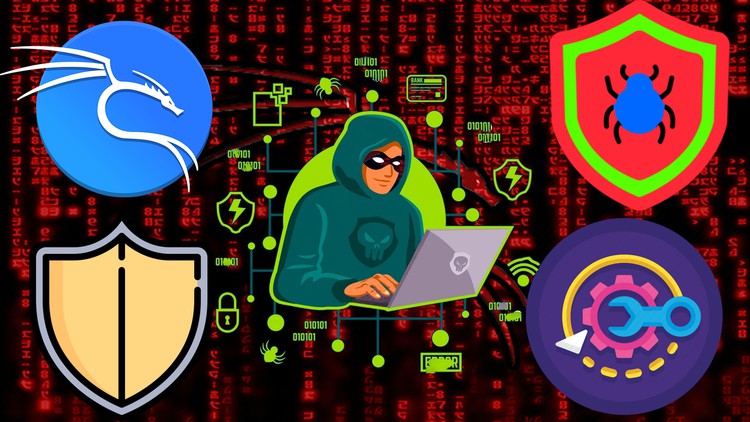
Master Reverse Engineering, Malware Analysis, Linux, Cyber Security, Ghidra, Game Hacking, IDA Pro, IDA Free, C++ and C!
What you will learn
Launch a career in cybersecurity: Gain practical expertise in reverse engineering and malware analysis opening doors to lucrative opportunities in the field.
Unveil the secrets of malware: Discover how to dissect and analyze malicious code to understand its inner workings with Reverse Engineering and Malware Analysis
Master reverse engineering techniques: Acquire essential skills to unravel complex software and uncover hidden vulnerabilities.
Protect against cyber threats: Learn to identify, analyze, and neutralize malware, bolstering your defense against cyber attacks.
Dive into the world of cutting-edge tools: Explore industry-standard software like Ghidra and IDA Pro to dissect malware with precision.
Understanding the concepts of symbols, stripped, and non-stripped binaries.
Analyzing and examining binary executables for comprehensive insights.
Utilizing READELF to view symbolic information in binary files.
Revealing the contents of object files through detailed analysis.
Exploring the theory behind disassembly and disassemblers’ functionality.
Gaining in-depth knowledge of how binary files load and execute.
Mastering the use of IDA Pro and IDA Freeware for advanced analysis.
Exploring useful tabs in IDA Pro to enhance reverse engineering.
Streamlining the process of downloading and installing IDA Pro \ IDA Freeware.
Acquiring comprehensive skills in malware analysis with Ghidra.
Conquering reverse engineering techniques using Ghidra’s powerful tools.
Leveraging OSINT to enhance reverse engineering effectiveness.
Initiating real malware analysis with Ghidra for hands-on experience.
In-depth analysis of libraries utilized by malware for a thorough understanding.
Extracting crucial information from suspicious strings using Ghidra.
Acquiring advanced techniques to extract SYS files from malware.
Understanding the fundamentals of the Windows PE format in detail.
Simplifying the process of installing JDK in Linux environments.
Downloading Ghidra and exploring its comprehensive file structure.
Effortlessly installing JDK in Windows or MacOS for seamless operation.
Gaining a comprehensive understanding of the compilation phase in binary analysis.
Exploring the preprocessing stage’s significance in binary analysis.
Comprehensive analysis of binaries and the four stages of compilation.
In-depth understanding of the linking phase’s role in binary analysis.
Demystifying the complexities of the assembly phase in binary analysis.
Mastering the art of opening projects in Ghidra for efficient workflow.
Discovering the vast features and capabilities of Ghidra for effective analysis.
Exploring ELF fields in Linux to grasp the intricacies of the format.
In-depth exploration of the Executable and Linkable Format (ELF) and its executable header.
Understanding ELF program header fields and their significance in Linux.
Understanding Linux commands and pipes.
Exploring different Linux commands and their usage with pipes.
Introduction to the Linux terminal and its key concepts.
Finding helpful manuals and resources for Linux.
Understanding Linux directories and their organization.
Understanding the Linux shell and its role in interacting with the system.
Working with the LS command to list directory contents.
Understanding the difference between relative and absolute pathnames.
Filtering LS output based on specific criteria.
Introduction to shell and expansion in Linux.
Manipulating files and directories in Linux.
Working with symbolic and hard link files.
Utilizing tab auto-completion for faster command entry.
Copying files and directories using the CP command.
Networking with Linux and its various tools and commands.
Working with the Traceroute (Trcrt) command for network diagnostics.
Two networks communicating with a router in the middle.
Inheritance and polymorphism
File input and output operations in C++
Dynamic memory allocation in C++
Recursion and backtracking in C++
Multi-threading and concurrency in C++
Debugging and error handling techniques in C++
Performance optimization techniques in C++
Description
Unlock the Power of Reverse Engineering and Malware Analysis: Dive into a captivating journey that unravels the secrets of malicious code and equips you with the skills to combat cyber threats. Our comprehensive online course combines theory, hands-on practice, and cutting-edge tools to transform you into a proficient reverse engineering and malware analysis expert.
Embark on a captivating adventure where you’ll demystify the intricate world of malware. Discover how to dissect and analyze malicious code, unveiling its hidden intentions and methodologies. Gain a profound understanding of malware behavior, enabling you to identify, analyze, and neutralize cyber threats effectively.
Master the art of reverse engineering as you delve into complex software structures. Uncover vulnerabilities, understand intricate algorithms, and decode obfuscated code. With hands-on exercises and real-world examples, you’ll acquire essential skills to navigate intricate software landscapes confidently.
Embrace a world of cutting-edge tools and industry-standard software. Explore the powerful capabilities of Ghidra and IDA Pro, harnessing their potential to dissect malware with precision and efficiency. Unlock their hidden features, develop advanced analysis techniques, and sharpen your expertise in a practical, real-world environment.
This course isn’t just for beginners; it’s tailored for intermediate learners seeking to expand their knowledge and elevate their skills to the next level. Each module builds upon the previous one, providing a comprehensive and structured learning experience. From understanding the fundamentals to delving into advanced techniques, you’ll progress systematically and gain confidence in your abilities.
But it doesn’t stop there. Professionals in the cybersecurity and IT fields will find immense value in this course. Enhance your expertise, augment your defense strategies, and fortify your organization against cyber threats. Acquire the skills necessary to investigate sophisticated attacks, analyze malicious software, and develop robust countermeasures.
Unlock endless opportunities as you complete this course. Whether you aspire to work as a cybersecurity analyst, incident responder, or malware researcher, the knowledge and practical experience gained will open doors to lucrative careers in the cybersecurity industry.
Enroll now and embark on a best learning journey. Unleash your potential in reverse engineering and malware analysis, and become an indispensable defender against cyber threats. Take charge of your cybersecurity destiny, protect what matters, and join the league of experts safeguarding our digital world.
Content